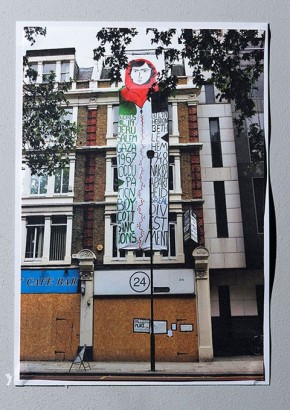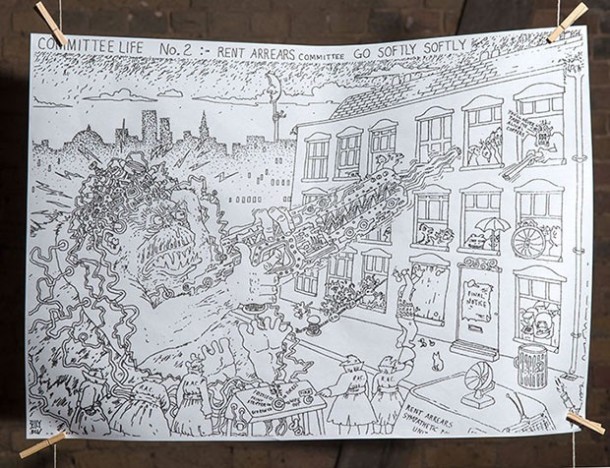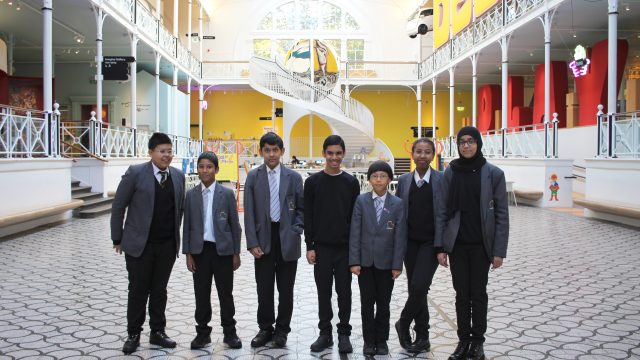Amongst the banners in the first room of Disobedient Objects is ‘Kraken Gaat Door’ (Squatting Goes On). This specific banner was made in the 1980s, forming part of a multi-year direct action campaign in Amsterdam. However, this fight for affordable housing solutions is a widespread, international, and simultaneously local.
In this post, guest blogger Luther Blissett writes a first hand account of squatting, its history, and the foundations of the UK based Made Possible By Squatting archive. You can check out Made Possible By Squatting’s new website here.

Walking around the current Disobedient Objects exhibition at the V&A, I wonder where these objects were made. How did people find physical space to build these tools for social change? Particularly when the act and the objects produced are the very antithesis to their environment – dominated by capitalist property relations?
Were they made in artist studios? In friend’s living rooms late into the night? In squatted buildings?
Running through social movements from the last 40 years is the act of squatting- to occupy, to reclaim, to self-organise (space) – to find a home when housing has become a luxury.

Of course squatting has a rich history that goes back much further than this.There are many stories of squatters we don’t often hear about in the media. These include stories of the preacher Francis of Assisi roaming the Italian countryside and bringing life back to dilapidated buildings, the British soldiers returning from the Second World War who had lost their homes and had to squat, the stories of The Diggers and their occupation of St George’s Hill in 1649 to defy the landlords who were ‘enclosing’ the land for their own wealth. To recount these instances is to name but a couple, a drop in an ocean of many histories
When the Con-Dem government moved to criminalise the squatting of residential property in 2012, sections of the right-wing press began a scaremongering campaign to vilify squatters. The general public did not hear of adventure playgrounds, women refuges, skateparks, bicycle workshops, housing co-ops and the community gardens that make up some squatting histories. Instead, they heard hyperbolic horror reports presented as fact – like those of squatters jumping in your window as you went out for a pint of milk. At points it felt like, “what have they come up with today?”
The proposed law went through in September 2012 despite 95% of respondents to the government consultation saying that they felt the current laws on squatting were sufficient – as did the lawyers, the judges, and the police. This is what democracy looks like.
Frustrated at the dominant storytelling (bashing) about squatting in the media, and rumblings of an extension of the new law to commercial buildings a group of friends decided it was time to collect stories of squatting and create a live archive open to the public. We named the project Made Possible by Squatting, a slogan used by Amsterdam squatters trying to defend their right to squat a few years before.

This process was as much about exhibiting the vital role squatting has played in shaping cities and the lives of people in them, as it was about learning from the experiences of generations of squatters before us. To aim to use these histories to understand our own present situation- and to form ideas for the future in a period of repression.
Our call for photographic, video, audio, sculpture, posters and performance was met with over 30 submissions. And when deciding what would appear in Made Possible by Squatting, we agreed to include all suggested pieces of work. This came from a collective feeling that as a handful of people we didn’t have the right to reject someone’s personal squatting story in an exhibition celebrating squatting history. So we developed a process that aimed to be inclusive, open to a wide breadth of stories and reflect the DIY, collective culture that is so often infused with the act of reclaiming space.

For some the lack of a heavier curation tactic meant that the archive we facilitated was too disjointed in its presentation. Whilst for others who came at both ends of the week-long space, there was excitement to see how it grew day-to-day, as more and more materials were brought and added to this slice of squatting history. One squatting old-timer brought in two boxes of flyers, posters and photographs that he had collected over twenty years. Before joining the archive, these boxes were just sitting in an attic.
A week before Made Possible by Squatting was due to open to the public an empty building on Dock Street in East London was squatted, and preparations on making the space began. Groups of squatters from around London came to support the archive’s construction. Actions ranged from fixing the electricity, to bringing food and supplies, and installing the exhibits. Combined with a weeklong workshop, this collective effort saw the archive take on a dynamic social aspect. Made possible by Squatting facilitated new informal relationships that are so characteristic of squatting culture, and vital in defending our ability to put into use disused space.

On reflection of the process to design and facilitate Made Possible by Squatting I find that the form of the archive and the way it was produced is of the history that we aimed to exhibit. It was in and of itself. On entering the building on Dock Street you were occupying the space, you were a squatter, and entering into the culture in which the objects you interact with also came from.
In Revolution, Rebellion, Resistance: The Power of the Story, Eric Selbin characterises key components of storytelling and history-forming as myth, memory, mimesis, and explores how these feed into moments of revolutionary social change. In opening up a privately-owned empty building in the east end of London and filling three stories with stories- perhaps these memories for the hundreds of people that came to the archive will form new myths, and propel mimesis into how we occupy space on our own terms and amidst the neo-liberal agenda of gentrification and power-over our lives.

You can see the archive material from Made Possible by Squatting at www.madepossiblebysquatting.co.uk, and an interactive walk-through of the Dock Street exhibition by photographer Adrian Nettleship at http://www.adriannettleship.com/mpbsv0.95/.
Written by Luther Blissett- one person in a collective of many that made Made Possible by Squatting possible



So honored by the shout out and so wish i could come see the exhibit….la lucha sigue.